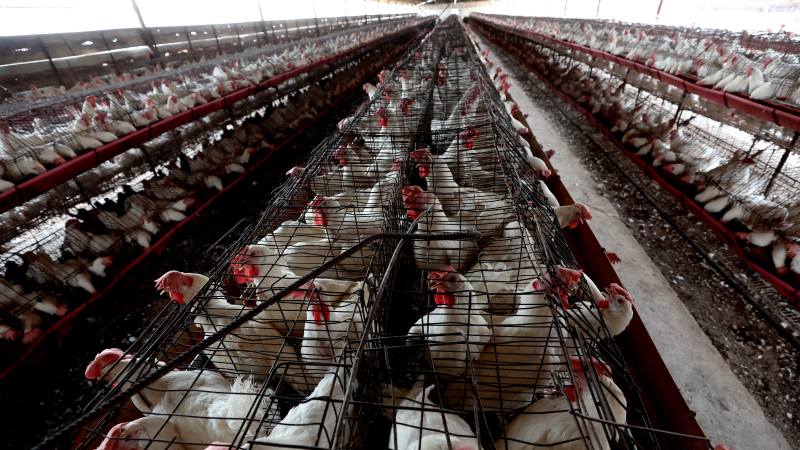CDC says salmonella outbreak linked to bearded dragons has spread to nine states
The Centers for Disease Control and Prevention is investigating a multistate salmonella outbreak linked to pet bearded dragon lizards.
While bearded dragons are popular pets, they are also prone to carrying germs that can easily cause illness in humans, especially children, the CDC said in a warning Friday. As of June 14, the ongoing investigation has found a total of 15 people in nine states who have gotten salmonella illnesses in the outbreak, the agency said.
Though they are generally considered easier to keep than other reptile species, the CDC does not suggest bearded dragons be kept as pets for children younger than 5, adults 65 or older, or people with weakened immune systems.
In the ongoing outbreak, nearly 60% of cases have been found in children under the age of 5, the CDC said.
Here's what to know about the ongoing salmonella outbreak.

Salmonella and cucumbers:FDA, CDC continue to investigate salmonella outbreaks likely tied to cucumbers
CDC: Current salmonella outbreak linked to bearded dragons
The CDC is currently aware of 15 cases of salmonella disease linked to bearded dragons in nine states, four of which required hospitalization. Illnesses started on dates ranging from Jan. 8, 2024 to May 16, 2024, and no deaths have been reported.
Twelve of the fifteen impacted people were interviewed and the CDC found that 58% reported direct contact with a breaded dragon before getting sick.
In at least one instance, a child did not directly touch the bearded dragon but may have been exposed via indirect contact, the CDC said. Most people had close contact with their pets at home, including touching the animal or its enclosure, feeding it or putting it on their laps, heads or shoulders.
As with most outbreaks, the actual number of cases is likely higher than those recorded by health officials, as many people recover at home without testing and it generally takes three to four weeks to determine if a sick person is part of an outbreak cohort, the CDC says.
Bearded dragons and salmonella: Outbreak of cases in nine states
The CDC says related cases were reported in nine states:
- California
- Georgia
- Iowa
- North Carolina
- New York
- Ohio
- Oklahoma
- Tennessee
- Texas
New York is home to the most cases with four, followed by Ohio with three and California with two. All other states reported only one case.

Salmonella risk from pets
This is not the first time the CDC has issued warnings about the spread of salmonella via pets, especially reptiles. Similar such warnings for other creatures, like small shell turtles, have been issued in the recent past.
And in 2022, the CDC investigated a salmonella outbreak linked to bearded dragons in which at least 44 people in 25 states got sick, and at least 15 were hospitalized.
According to the CDC, bearded dragons can carry salmonella germs in their droppings even if they look healthy and clean. Touching your lizard or anything in its environment and then touching your face, mouth or food can lead to the ingestion of germs that can lead to salmonella poisoning.

Bearded dragon lovers: Safety tips to avoid salmonella infection
The CDC suggests the following safety tips when interacting with your pet reptile:
- Wash your hands: Anyone who touches or feeds your bearded dragon should always wash their hands thoroughly with soap and water right after that. Also wash your hands after touching or cleaning the area where it lives and roams. This is especially important before someone holds or feeds a baby or child under the age of 5.
- Play safely: Don’t kiss or snuggle your bearded dragon, and don’t eat or drink around it. This can spread salmonella germs to your mouth and make you sick. Have a dedicated enclosure for your bearded dragon; it shouldn't roam in the same spaces where your baby or young children crawl and play. Keep your bearded dragon out of your kitchen and other areas where you eat, store, or prepare food.
- Keep things clean: Clean your bearded dragon supplies – such as feeders, toys, and food and water containers – outside of the house, if possible. If you must clean the supplies indoors, don’t clean them in the kitchen or other areas where you eat or prepare food. Use a laundry sink or bathtub, and thoroughly clean and disinfect the area afterward.
Salmonella illness symptoms and treatment
The CDC advises looking out for the following symptoms:
- Bloody diarrhea or diarrhea that lasts more than three days without improving.
- Diarrhea and a fever over 102 degrees Fahrenheit.
- Excessive vomiting, especially if it prevents you from keeping liquids down.
- Signs of dehydration, including dry mouth and throat, infrequent urination and feeling dizzy when standing up.
- Stomach cramps.
These symptoms most commonly occur between six hours and six days after exposure. Though most people recover in four to seven days, those with weakened immune systems, including children younger than 5 and adults over 65, may experience more severe symptoms that require medical treatment or hospitalization.
Disclaimer: The copyright of this article belongs to the original author. Reposting this article is solely for the purpose of information dissemination and does not constitute any investment advice. If there is any infringement, please contact us immediately. We will make corrections or deletions as necessary. Thank you.


